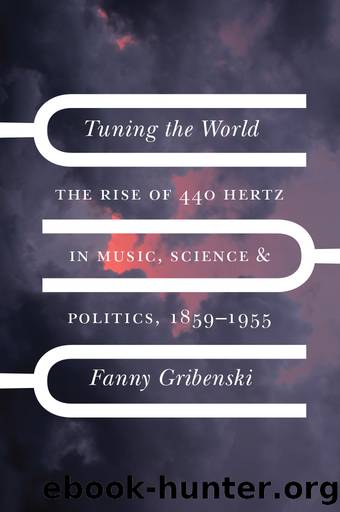Tuning the World by Fanny Gribenski;

Author:Fanny Gribenski; [Gribenski, Fanny]
Language: eng
Format: epub
Tags: MUS000000 MUSIC / General, MUS020000 MUSIC / History & Criticism, SCI001000 SCIENCE / Acoustics & Sound, MUS054000 MUSIC / Philosophy & Social Aspects
Publisher: University of Chicago Press
Published: 2023-01-25T00:00:00+00:00
In order to ascertain whether the European orchestras keep the concert pitch a [A] 435 Hz. vibrations per sec., as agreed at the International Conference for Concert Pitch in Vienna, tests were made to check the musical broadcasts of as many stations as possible with a view to measuring their concert pitch.62
The PTRâs involvement with pitch was not new. After the Vienna conference of 1885, the institution became Germanyâs control center for tuning forks.63 Lottermoserâs study, however, with its emphasis on sound recording and broadcasting, was part of the Third Reichâs new scientific agenda. The experiment took place in the recently opened acoustical laboratory. Created in 1934, this institution was very much a response to the Nazi stateâs demand that the nationâs physicists abandon pure research in favor of practical experiments that would support domestic interests.64 In this way, the PTRâs scientific program became increasingly politicized. The work of the acoustic laboratory was primarily aimed at undergirding Germanyâs rapid militarization and war preparation, contributing to the production of acoustic mines and acoustically controlled torpedoes.65 At the same time, it was conceived of as an aid to the development of Germanyâs national music and sound industries, including instrument making, broadcasting, recording, and motion pictures, itself useful to creating Nazi propaganda.66
Grützmacher was appointed head of the institutionâs acoustic laboratory amid the reconfiguration of the PTRâs scientific agenda. An authority on acoustics, he was not only experienced in scientific research, but had worked in commerce and industry. This straddling of industry and university research was typical for acousticians of Grützmacherâs generation. A doctor in physics, Grützmacher started working on acoustics while he was an employee at the Telegraphentechnische Reichsamt.67 In 1930 he became the director of the acoustic laboratory of the Reichspostzentralamt, where he elaborated a new practice for sound analysis and, in collaboration with Erwin Meyer, a new arrangement to measure the spectrum of musical instruments.68
Grützmacher pursued these sonorous experiments at the PTR, where he developed an apparatus for measuring and visualizing the fundamental pitches of speech that was to become a reference for phonetic research after World War II.69 Starting in 1935, Grützmacher also initiated experiments on the pitch of musical instruments, including pianos, organs, and wind instruments.70 In these endeavors he collaborated with Lottermoser who, having just received his doctorate in physics with a thesis on the sound of reed pipes, was keen to volunteer at the PTR. An enthusiastic admirer of German organ building since his youth in Dresden, Lottermoser embraced the career of a physicist to try to explain the fascination that organ sounds produced on him, and indeed devoted most of his career to the study of the instrument.71 Grützmacher valued Lottermoserâs training as a musician, which provided the laboratory with essential skills for experimenting on musical instruments.72 Lottermoserâs profile and particular interest in music and aesthetics in turn shaped the PTRâs approach to acoustics and subsequent intervention into the question of pitch conversations.
The PTRâs work on the pitch of musical instruments was very much part of the institutionâs new nationalistic scientific policy.
Download
This site does not store any files on its server. We only index and link to content provided by other sites. Please contact the content providers to delete copyright contents if any and email us, we'll remove relevant links or contents immediately.
| Appreciation | Blank Sheet Music |
| Composition | Conducting |
| Exercises | Instruction & Study |
| Lyrics | MIDI, Mixers, etc |
| Philosophy & Social Aspects | Songwriting |
| Techniques | Theory |
| Vocal |
The Goal (Off-Campus #4) by Elle Kennedy(12455)
Kathy Andrews Collection by Kathy Andrews(10561)
Diary of a Player by Brad Paisley(6872)
What Does This Button Do? by Bruce Dickinson(5538)
Assassin’s Fate by Robin Hobb(5256)
Big Little Lies by Liane Moriarty(4894)
Pale Blue Dot by Carl Sagan(4020)
Sticky Fingers by Joe Hagan(3459)
The Heroin Diaries by Nikki Sixx(2943)
The Death of the Heart by Elizabeth Bowen(2911)
Beneath These Shadows by Meghan March(2731)
The Help by Kathryn Stockett(2711)
Confessions of a Video Vixen by Karrine Steffans(2685)
How Music Works by David Byrne(2541)
Jam by Jam (epub)(2498)
Harry Potter 4 - Harry Potter and The Goblet of Fire by J.K.Rowling(2423)
Strange Fascination: David Bowie: The Definitive Story by David Buckley(2371)
Petty: The Biography by Warren Zanes(2242)
Darker Than the Deepest Sea by Trevor Dann(2214)
